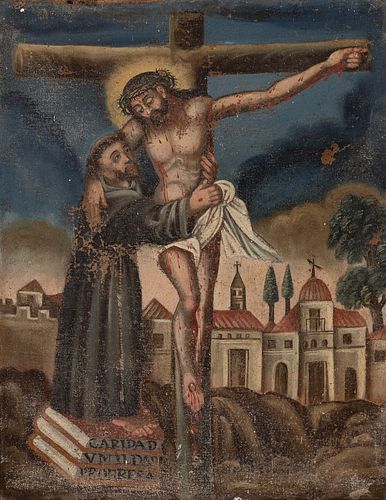Novo-Hispanic school; end of the 18th century."St. Francis embracing Christ".Oil on canvas.
Lot 2
About Seller
Setdart Auction House
Carrer Aragó 346
Barcelona
Spain
Setdart Subastas was born in 2004 and is currently the first online art auction in Spain with solidity, prestige and reliability guaranteed by our more than 60,000 users. Setdart has a young, dynamic and enterprising team ready to successfully manage the purchase and sale of art works through custom...Read more
Estimate:
EUR€300 - EUR€500
$322.58 - $537.63
Absentee vs Live bid
Two ways to bid:
- Leave a max absentee bid and the platform will bid on your behalf up to your maximum bid during the live auction.
- Bid live during the auction and your bids will be submitted real-time to the auctioneer.
Bid Increments
| Price | Bid Increment |
|---|---|
| EUR€0 | EUR€10 |
| EUR€200 | EUR€25 |
| EUR€500 | EUR€50 |
| EUR€1,000 | EUR€100 |
| EUR€3,000 | EUR€200 |
| EUR€5,000 | EUR€500 |
| EUR€10,000 | EUR€1,000 |
| EUR€20,000 | EUR€2,000 |
| EUR€50,000 | EUR€5,000 |
About Auction
By Setdart Auction House
Jul 14, 2021
Set Reminder
2021-07-14 06:30:00
2021-07-14 06:30:00
America/New_York
Bidsquare
Bidsquare : OLD MASTERS
https://www.bidsquare.com/auctions/setdart-auction-house/old-masters-7202
Setdart Auction House sofia@setdart.com
Setdart Auction House sofia@setdart.com
- Lot Description
Novo-Hispanic school; end of the 18th century. "St. Francis embracing Christ". Oil on canvas. Presents canvas detached from the frame and original frame. Size: 58 x 44,5 cm; 66 x 53 cm (frame). Devotional scene that presents a certainly naïf aesthetic, presenting an image of thick lines, very delimited, with very defined color space. In the image, St. Francis, leaning on the three vows of the Franciscans, embraces Christ by the waist. Christ, who is on the cross, rests his arm on the saint, in an attitude of heaviness. St. Francis (Assisi, Italy, 1182 - 1226) was the son of a wealthy Italian merchant. Baptized as John, he was soon known as "Francesco" (the little Frenchman), because his mother came from that country. His youth was joyful and carefree until the age of twenty-five, when he changed completely and began to dedicate himself to the service of God, practicing the Gospel ideal: purity, detachment and joy in peace. Francesco renounces the great inheritance received from his parents and decides to live poorly, giving an example of authentic Christianity. He soon had several young disciples, called by the saint "order of the Friars Minor". In 1210, Pope Innocent III granted them the foundation of the new order and encouraged them in their evangelical tasks. During a retreat on the mountain, Christ appeared to him, and legend has it that from his wounds came rays that caused Francis various stigmata. He was a legendary character during his lifetime, considered a living relic. Likewise, his exquisite poetry and his familiarity with nature add the most human accent known in a saint, as can be appreciated in his "Canticle to the Sun". It is worth mentioning that during the Spanish colonial domination, a mainly religious painting was developed, aimed at Christianizing the indigenous peoples. The local painters were modeled on Spanish works, which they followed literally in terms of types and iconography. The most frequent models were the harquebusier angels and the triangular virgins, however, it was not until the first years of the 19th century, already in times of independence and political opening of some of the colonies, that several artists began to represent a new model of painting with its own identity.
- Shipping Info
-
In-house shipping available. Please inquire at admin@setdart.com.
-
- Buyer's Premium



 EUR
EUR CAD
CAD AUD
AUD GBP
GBP MXN
MXN HKD
HKD CNY
CNY MYR
MYR SEK
SEK SGD
SGD CHF
CHF THB
THB













